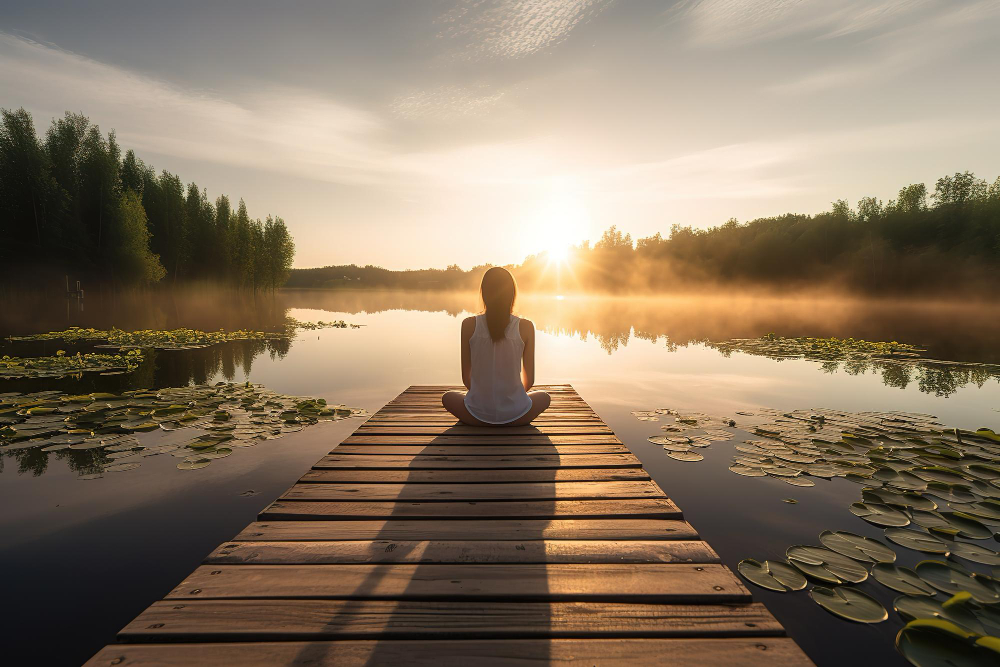Stillness Is Where You Find Answers: The Power of Inner Silence
In a world that never slows down, I’ve discovered something profound: stillness isn’t just a pleasant break from chaos—it’s where the answers we desperately seek have been hiding all along.
I remember the day this realization hit me. I was sitting in traffic, drumming my fingers impatiently on the steering wheel, mind racing through my endless to-do list, when I happened to glance at a small bird perched perfectly still on a nearby fence. In that moment, watching its quiet presence amidst the rush hour madness, something shifted inside me. What if all this mental noise wasn’t helping me solve my problems, but actually drowning out the wisdom already within me?
That question led me on a journey to explore how stillness—that rare commodity in our hyper-connected lives—might be the missing piece in our collective quest for clarity, purpose, and inner peace.
Why We’ve Lost Touch with Stillness
Today’s world runs on constant stimulation. Our smartphones ping with notifications before we’ve even had our morning coffee. Social media feeds refresh endlessly. Work emails arrive at all hours. Even our “downtime” often involves screens, noise, and passive consumption.
This isn’t just busyness—it’s a form of modern addiction. Research shows that the average person checks their phone 96 times daily—once every 10 minutes—and this constant connectivity fundamentally alters our relationship with silence and stillness.
As a society, we’ve developed what psychologists call “silence anxiety”—a discomfort with quiet moments that drives us to fill any potential gap with noise, information, or distraction. When was the last time you sat in complete silence, without reaching for your phone or turning on background music? For many of us, that question is surprisingly difficult to answer.
But this disconnection from stillness comes at a significant cost to our mental clarity, emotional wellbeing, and even our ability to access our own inner wisdom.
Stillness: The Natural State We’ve Forgotten
Ironically, stillness isn’t some exotic practice we need to learn—it’s actually our most natural state. Before the industrial revolution, before electricity, before the internet, humans spent far more time in relative quiet. Our ancestors knew darkness at night, real silence in nature, and the rhythmic pace of days dictated by sunrise and sunset rather than endless notifications.
Think about young children before they’re given devices. They naturally slip in and out of states of focused attention and quiet daydreaming. Watch a toddler become completely absorbed in examining a leaf or a raindrop—they embody present-moment awareness without trying.
As adults, we haven’t lost this capacity for stillness—we’ve just buried it under layers of distraction and cultural conditioning that equates productivity with worth.
But here’s the beautiful truth: stillness remains available to us at any moment. It’s not something we need to achieve or earn; it’s simply a matter of remembering how to return to this innate state of being.

The Science Behind Stillness: How Quiet Transforms Your Brain
What happens in your brain when you finally stop the constant input and allow yourself to experience stillness? The neuroscience is fascinating.
The Default Mode Network and Mental Chatter
When your mind is wandering or ruminating, a collection of brain regions called the Default Mode Network (DMN) becomes highly active. This network is associated with self-referential thinking, planning, ruminating about the past, and worrying about the future—essentially, it’s your brain’s “autopilot” mode.
While some DMN activity is normal and necessary, excessive activation is linked to anxiety, depression, and reduced cognitive performance. Here’s where stillness practices become powerful: neuroimaging studies show that meditation and mindfulness significantly reduce DMN activity, effectively quieting the mental chatter that clouds our thinking.
Dr. Sara Lazar, a neuroscientist at Harvard Medical School, found that regular meditation not only decreases DMN activity but actually changes brain structure. After just eight weeks of meditation practice, participants showed increased gray matter density in brain regions associated with learning, memory, emotional regulation, and perspective-taking.
The Stress Response and Clarity
When we’re constantly bombarded with stimuli and rushing from one task to another, our bodies remain in a low-grade fight-or-flight state. This chronic stress response floods our systems with cortisol and adrenaline, which are fantastic for helping us outrun predators but terrible for clear thinking and intuitive decision-making.
Stillness practices activate the parasympathetic nervous system—our “rest and digest” mode—which counteracts these stress hormones. When the parasympathetic system engages, our breathing slows, blood pressure decreases, and digestive function improves. This physiological state creates the perfect conditions for mental clarity.
A 2018 study published in the journal Consciousness and Cognition found that just 10 minutes of mindful breathing significantly improved participants’ ability to concentrate and make decisions. The researchers concluded that even brief stillness practices can create “measurable improvements in cognitive function and emotional regulation.”
Alpha Waves and Creative Insight
During moments of stillness, our brains generate more alpha waves, which are associated with relaxed alertness and creative insight. This is why great ideas often come to us in the shower, while walking in nature, or just before falling asleep—moments when we’ve temporarily stepped away from stimulation and allowed our minds to settle.
Thomas Edison famously harnessed this phenomenon. When stuck on a problem, he would sit in a chair holding metal balls in his hands with metal pans placed beneath. As he drifted toward sleep (a state rich in alpha waves), the balls would drop, waking him so he could immediately record any insights that had emerged during this liminal state of consciousness.
This isn’t magical thinking—it’s neuroscience. Stillness creates the optimal brain state for connecting disparate ideas and accessing intuitive knowledge that often remains below the threshold of conscious awareness during our busy, beta-wave dominated days.
How Stillness Connects Us to Inner Wisdom
Beyond the measurable brain changes, stillness offers something even more valuable: access to our inner wisdom. This isn’t about receiving mysterious messages from beyond—it’s about finally being able to hear what your own deeper knowing has been trying to tell you all along.
The Wisdom of the Body
Our bodies constantly communicate with us through physical sensations, emotions, and subtle energetic shifts. When we’re chronically busy and disconnected from stillness, we often override these important signals, pushing through fatigue, ignoring stress responses, and dismissing gut feelings.
Through stillness practices, we can rebuild this vital connection to bodily wisdom. Many people report that after establishing a regular meditation practice, they become more attuned to their body’s signals—recognizing earlier when they need rest, when something doesn’t feel right in a situation, or when they’re making choices aligned with their deeper values.
This bodily wisdom isn’t separate from intellectual understanding—it’s a complementary form of intelligence that provides crucial data our thinking minds might miss. The phrase “trust your gut” exists for good reason; our enteric nervous system (often called our “second brain”) contains over 100 million neurons and produces many of the same neurotransmitters found in the brain, including 95% of our serotonin.
Intuition Clarified
Intuition isn’t mystical—it’s your brain processing information below the threshold of conscious awareness. Your mind constantly absorbs and analyzes countless subtle cues, patterns, and signals from your environment. Intuitive “hits” occur when this unconscious processing rises to consciousness as a feeling or knowing.
The problem is that intuition speaks softly. When our attention is constantly hijacked by external stimuli and mental noise, these subtle intuitive nudges get drowned out. Stillness creates the quiet inner environment where intuition can finally be heard.
Research from the Max Planck Institute found that decisions made during states of quiet reflection often prove more accurate and satisfying than those made during active thinking. The scientists concluded that unconscious processing—which flourishes in stillness—can handle more complex information than conscious reasoning alone.
The Space Between Thoughts
Eastern wisdom traditions have long taught that our true nature—and our deepest wisdom—exists in the space between thoughts. While this might sound esoteric, modern neuroscience lends some fascinating support to this ancient insight.
When we quiet the constant stream of thinking through meditation or other stillness practices, we sometimes experience moments of pure awareness without conceptual overlay. In these gaps between thoughts, many people report experiencing insights that have a different quality than ordinary thinking—they arrive whole, with a sense of clarity and rightness that feels undeniable.
Neuroscientists studying these states have observed unique brain patterns that combine high alertness with deep relaxation. This paradoxical state allows us to access knowledge and perspectives that remain inaccessible during normal waking consciousness.

Practical Ways to Cultivate Stillness in Everyday Life
Cultivating stillness doesn’t require moving to a mountaintop or spending hours in meditation (though neither would hurt!). Small, consistent moments of stillness can gradually transform your relationship with yourself and unlock your inner wisdom. Here are some practical approaches to incorporate stillness into your daily life:
1. Start Your Day with Intentional Stillness
The first moments after waking set the tone for your entire day. Instead of immediately reaching for your phone (which puts your brain into reactive mode), try spending 5-10 minutes in stillness. This could be formal meditation, quiet breathing, or simply sitting by a window observing the morning light.
This morning stillness practice creates a buffer between sleep and the demands of the day, allowing you to center yourself before engaging with external pressures. Many successful people across disciplines—from CEOs to artists—credit their morning stillness ritual as essential to their clarity and creativity.
2. Create Stillness Pauses Throughout Your Day
Our brains aren’t designed for non-stop activity. Research shows that attention naturally cycles approximately every 90 minutes, with periods of higher focus followed by dips in concentration. Instead of pushing through these natural lulls with caffeine or willpower, try using them as intentional stillness breaks.
Set a gentle reminder on your phone or computer to take a 3-minute stillness pause every 90 minutes. During these brief intervals, step away from screens, close your eyes if possible, and take several deep breaths. Even these micro-moments of stillness can reset your nervous system and clear mental fog.
3. Practice Mindful Transitions
Modern life involves countless transitions—from home to work, from one meeting to another, from work mode to family time. These transitions offer natural opportunities to practice stillness if we stop treating them as mere inconveniences to rush through.
Before starting your car, take three conscious breaths. When arriving home, pause for a moment on your doorstep to mentally release the day. Before entering an important meeting, give yourself 30 seconds of stillness to center and clarify your intentions.
These small transition rituals provide brief but powerful moments of stillness that can prevent the mental residue of one activity from contaminating the next.
4. Rediscover the Power of Nature
Nature offers one of the most accessible and profound portals to stillness available to us. Studies show that even brief exposure to natural environments reduces stress hormones, lowers blood pressure, and improves mood—all physiological shifts that support inner clarity.
Try spending 20 minutes in a park, garden, or natural setting without your phone. Instead of just passing through nature, really observe it—notice the patterns in tree bark, watch clouds change shape, listen to the layered sounds of birds and leaves. This sensory immersion naturally quiets the thinking mind and activates our innate capacity for present-moment awareness.
5. Create a Stillness Sanctuary at Home
Designate even a small corner of your home as a stillness sanctuary—a place free from screens, work materials, and reminders of responsibilities. Keep this space visually simple and associate it only with quiet reflection, meditation, or contemplative practices.
Having a physical location reserved for stillness sends a powerful signal to your brain that when you enter this space, it’s time to shift from doing mode to being mode. Over time, just sitting in this space can trigger the physiological relaxation response associated with stillness.
Overcoming Common Obstacles to Stillness
As you begin incorporating more stillness into your life, you’ll likely encounter some challenges. Understanding these common obstacles can help you navigate them skillfully:
The Discomfort of Beginning
Many people feel intensely uncomfortable when first practicing stillness. As external distractions fall away, we often come face-to-face with racing thoughts, uncomfortable emotions, or physical restlessness. This initial discomfort leads many to conclude they’re “bad at meditation” or that stillness isn’t for them.
What’s actually happening is that you’re finally noticing the constant mental activity that’s always been there—you’ve just been too busy to perceive it. This awareness, though initially uncomfortable, is actually the first step toward transformation. Be gentle with yourself during this phase and remember that even experienced meditators have busy minds; the skill isn’t having no thoughts but rather changing your relationship with thinking.
The Productivity Paradox
In our achievement-oriented culture, stillness can feel counterproductive. There’s a persistent voice that whispers, “You don’t have time for this—you should be doing something.”
Yet research consistently shows that periods of stillness actually enhance productivity, creativity, and decision-making. A study from the University of Illinois found that brief diversions from tasks dramatically improved participants’ ability to focus for prolonged periods. The most effective workers weren’t those who pushed through without breaks but those who alternated focused activity with brief periods of mental rest.
Remember: stillness isn’t an indulgence—it’s a practical strategy for optimizing your mind.
Digital Distractions and Environment
Our technological environment is deliberately designed to capture and hold our attention. Notifications, infinite scrolling features, and algorithm-curated content all exploit our brain’s natural attraction to novelty and variable rewards.
Creating more stillness requires honestly assessing your digital habits and making conscious adjustments. Try designating certain times of day as “notification-free” periods, keeping devices out of your bedroom, or using apps that temporarily block distracting websites during times you’ve dedicated to stillness practices.
Environmental cues can either support or undermine your intention for stillness. Simple changes like keeping a meditation cushion visible, creating a “charging station” for phones outside your bedroom, or placing nature objects on your desk can serve as physical reminders of your commitment to stillness.
The Transformative Impact of Stillness
When you commit to making stillness a regular part of your life, the benefits extend far beyond occasional moments of calm. Here’s how this practice can transform your experience:
Enhanced Decision-Making
Perhaps the most practical benefit of stillness is improved decision-making. When you regularly step back from mental noise, you develop the ability to distinguish between reactive thinking (based on fear, conditioning, or impatience) and clear inner guidance.
Many people report that after establishing a stillness practice, they make fewer impulsive decisions and feel more confident in their choices. Important decisions become less agonizing because you learn to trust the wisdom that emerges from quiet contemplation rather than endless pro/con lists or anxious rumination.
Emotional Resilience
Regular stillness practice creates space between stimulus and response—what psychiatrist and Holocaust survivor Viktor Frankl called “the space in which our power to choose our response lies.” This gap allows you to respond thoughtfully to life’s challenges rather than reacting automatically.
Over time, this developing space between trigger and response builds profound emotional resilience. Stillness doesn’t make difficult emotions disappear, but it changes your relationship with them. Instead of being completely identified with feelings like anger, fear, or sadness, you develop the capacity to observe these emotions with compassionate awareness.
Authentic Connection
Perhaps counterintuitively, deepening your relationship with stillness can dramatically improve your connections with others. When you’re constantly distracted, preoccupied, or mentally elsewhere, authentic connection becomes impossible.
Regular stillness practice helps you become fully present with the people in your life. You develop the capacity to really listen instead of just waiting for your turn to speak. You notice subtle emotional cues you previously missed. And perhaps most importantly, your increased self-awareness helps you show up more authentically in relationships rather than operating from habitual patterns or outdated defenses.
A Deepening Sense of Purpose
Many people report that as stillness becomes a regular practice, they gain increasing clarity about their deeper purpose and values. The constant noise of social comparison, cultural expectations, and others’ opinions gradually quiets, allowing your authentic desires and values to emerge.
This doesn’t necessarily mean dramatic life changes (though sometimes it does). More often, people describe subtle but significant shifts in priorities, a clearer sense of what truly matters to them, and more aligned daily choices that better reflect their deepest values.
The Lifelong Journey of Stillness
Cultivating stillness isn’t a one-time achievement but a lifelong journey. Some days you’ll find it easily; other days your mind will seem impossibly busy. The key is approaching this practice with curiosity rather than judgment, recognizing that each moment of returning to stillness strengthens your capacity for presence and clarity.
As you continue, you may notice that stillness isn’t just something you do—it gradually becomes part of who you are. The clarity and wisdom accessed in formal stillness practices begin to infuse your active life. The boundary between “meditation” and “everything else” becomes less distinct as you bring the quality of present awareness into more moments.
This is the ultimate gift of stillness: not just occasional insights or temporary calm, but a fundamental shift in how you experience your life—more present, more peaceful, and more intimately connected to the wisdom that has been within you all along.
The answers you seek have always been there, waiting patiently in the stillness. All you need to do is pause, breathe, and listen.
We may earn a commission for purchases made using our links. Please see our disclosure to learn more.




